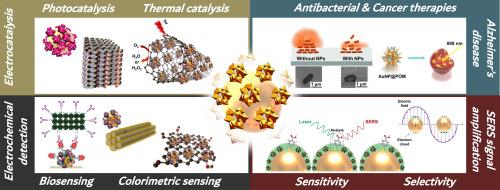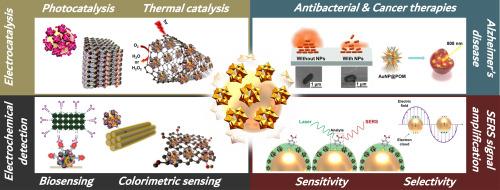金纳米颗粒-多金属氧酸盐复合材料:从合成和表征到应用的全面概述
IF 23.5
1区 化学
Q1 CHEMISTRY, INORGANIC & NUCLEAR
引用次数: 0
摘要
金纳米粒子以其独特的电子和光学性质及其广泛的应用而受到人们的关注。通过将aunp与其他分子或材料结合来开发混合纳米粒子是引入新功能和扩展其用途的有力途径。特别是,金纳米颗粒可以与有机金属配合物、生物分子、配位聚合物或多金属氧酸盐(pom)结合,后者是一组由高氧化态过渡金属组成的可溶性阴离子金属氧化物。无机聚甲醛有各种各样的形状和大小,尤其因其生物和催化性能而受到重视。它们对于AuNPs复合材料的合成特别有趣,因为它们可以通过静电或共价相互作用和空间效应稳定纳米粒子,而不需要额外的表面活性剂的存在,通过光化学、电化学或化学还原或直接以还原形式使用来还原金阳离子,并赋予所得到的系统特性。聚甲醛还可以与感兴趣的有机分子共价结合,这反过来又有助于金纳米颗粒的功能。本文综述了直接包覆聚甲醛的金纳米颗粒及其合成和表征方法。还特别关注它们的应用,包括(照片)(电)催化,生物医学应用(抗菌,抗癌和抗阿尔茨海默氏症)以及它们作为传感器的使用。本文章由计算机程序翻译,如有差异,请以英文原文为准。


Gold nanoparticles–polyoxometalates composites: a comprehensive overview from synthesis and characterization to applications
Gold nanoparticles (AuNPs) have attracted attention for their unique electronic and optical properties and their wide range of applications. The development of hybrid nanoparticles by combining AuNPs with other molecules or materials is a powerful way of introducing new functions and extending their use. In particular, gold nanoparticles can be associated to organometallic complexes, biological molecules, coordination polymers or polyoxometalates (POMs), the latter being a group of soluble anionic metal oxides composed of transition metals in high oxidation states. Inorganic POMs come in a wide variety of shapes and sizes and are valued especially for their biological and catalytic properties. They are particularly interesting for the synthesis of AuNPs composites, as they can stabilize nanoparticles through electrostatic or covalent interactions and steric effects without the presence of additional surfactants, reduce gold cations by photochemical, electrochemical, or chemical reduction, or directly when used in their reduced form, and confer properties to the resulting systems. POMs can also be covalently combined with organic molecules of interest, which can in turn contribute to the functionalities of the gold nanoparticles. This review focuses on gold nanoparticles directly coated with POMs and covers their synthesis and characterization. Particular attention is also paid to their applications, including (photo)(electro)catalysis, biomedical applications (antibacterial, anticancer and anti-Alzheimer's) and their use as sensors.
求助全文
通过发布文献求助,成功后即可免费获取论文全文。
去求助
来源期刊

Coordination Chemistry Reviews
化学-无机化学与核化学
CiteScore
34.30
自引率
5.30%
发文量
457
审稿时长
54 days
期刊介绍:
Coordination Chemistry Reviews offers rapid publication of review articles on current and significant topics in coordination chemistry, encompassing organometallic, supramolecular, theoretical, and bioinorganic chemistry. It also covers catalysis, materials chemistry, and metal-organic frameworks from a coordination chemistry perspective. Reviews summarize recent developments or discuss specific techniques, welcoming contributions from both established and emerging researchers.
The journal releases special issues on timely subjects, including those featuring contributions from specific regions or conferences. Occasional full-length book articles are also featured. Additionally, special volumes cover annual reviews of main group chemistry, transition metal group chemistry, and organometallic chemistry. These comprehensive reviews are vital resources for those engaged in coordination chemistry, further establishing Coordination Chemistry Reviews as a hub for insightful surveys in inorganic and physical inorganic chemistry.
 求助内容:
求助内容: 应助结果提醒方式:
应助结果提醒方式:


